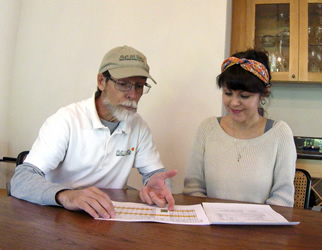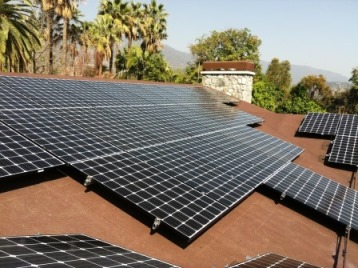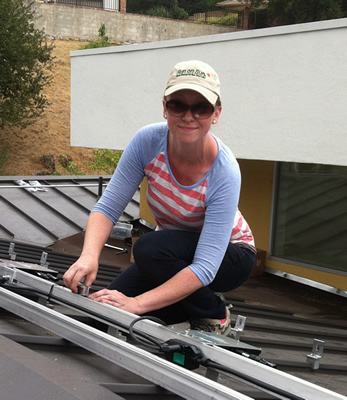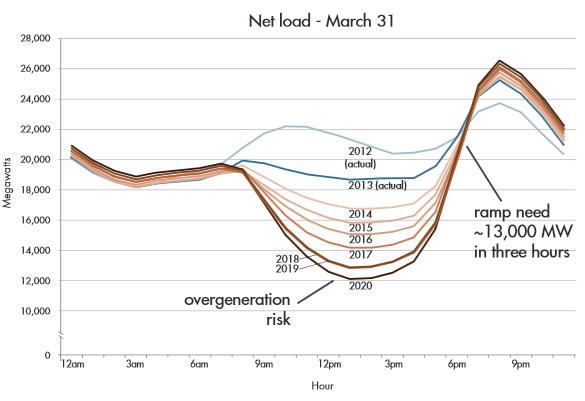Categories: "All About Solar Power"
01/28/16
Categories: All About Solar Power, Residential Solar, Ranting
The Run on Sun Approach to Solar...Without Salesmen
I like to think there are many ways in which Run on Sun stands out in the ever growing sea of solar contractors. But there is one particular feature which every client seems to comment on - our non-sales approach. I can’t count the number of times I have sat down at a kitchen table to discuss how solar works and whether it makes sense for that home, to hear remarks on how different the experience is compared to other solar pitches they’ve heard. The thing is, when someone from Run on Sun comes to your home to do a solar assessment, that person is not a sales person. We don’t have outside sales agents and we definitely don’t employ any “hard sell” tactics. As a small company, every employee is a solar professional who has taken the time to educate themselves on the intricacies of the industry. And perhaps more importantly, every Run on Sun employee truly takes pride in helping people go solar, for the right reasons.

Explaining more than selling
Some people might argue over what exactly are “the right reasons". The bottom line is this: we believe solar is an amazing solution to many problems the world faces today. From reducing the carbon emissions and water use over traditional power sources, and increasing the number of jobs with a living wage that cannot be outsourced, to providing property owners with huge savings over time — going solar is a great thing to do. But we can only accomplish growing this great solution if we do it ethically. The solar industry will only suffer by putting solar on spaces that aren’t good candidates and cause financial strain or debt for clients that would have been better off without solar.
In fact, our goal when we walk into a solar assessment is not to get a contract signed. Rather, the goal is to assess the solar potential accurately and make sure the client feels they have any and all questions answered about the process of going solar. And for clients who turn out to be great solar candidates, obviously we aim to help them save money, achieve some energy independence, increase the value of their property, and enjoy the peace of mind that using green energy provides!
During an assessment we work with clients to determine what the best solar system would be to meet their real energy needs as well as what would be their best possible investment. Then we take the time to explain exactly how we made the determinations that we did. Sometimes, as some of our Yelp! Reviewers have shared, that assessment leads to the unfortunate conclusion that solar is a poor investment for the client and we make sure to explain why. Perhaps external factors make the upfront cost too high such as re-roofing or electrical panel upgrades, or maybe the shade of that lovely oak tree would make any solar output too limited. Maybe your usage needs are just too low to justify all of the fixed costs to install. In these cases, the sad reality is that there are solar companies who would gladly install a system anyways and lock you into a contract which could cost you incredible amounts of money with little to no return.
As consumers ourselves, we’d rather make our own educated decisions especially regarding large purchases and investments. Being pressured into something is seriously a turn off. If you are influenced more by hard sales tactics, we likely won’t be the ones putting solar on your roof as there are plenty of other companies who have motivated salesmen knocking on your door. But at least we can go home feeling good about the work we do every day.
So if you’re interested in going solar but the thought of dealing with salesmen is revolting, never fear! Run on Sun would be happy to walk you through the process today.
10/13/15
Categories: All About Solar Power, Solar Economics, Residential Solar, Ranting
3 Rules to Avoid Shady Solar Contracts

So you’ve decided to go solar (congratulations!) and you are about to sign on the dotted line. Before you do, please take a moment and follow these three simple rules to avoid getting burned.
Rule #1 - Read the Contract!
It goes without saying that for a project as elaborate as a solar installation, a written contract is required. But a written contract will do you no good, and could do you a great deal of harm, if you don’t take the time to read it!
I know, I know, contracts are boring. But lawsuits are not, and the best way to avoid such excitement is to spend a little tedious time now laboring over the fine print.
We see examples of solar contracts all the time, and some of them are pretty appalling. Written in tiny fonts, they just beg you to give up and simply ask, “Where do I sign?” Resist that temptation at all costs, less you discover the hard way that some unscrupulous contractor (or even worse, his unscrupulous lawyer) has snuck some awful prevision into your contract. Think I’m exaggerating? Take this beaut for example, from a section on Change Orders:
The change in the Contract Price caused by such Contract Change Order shall be as agreed to in writing, or if the parties are not in agreement as to the change in Contract Price, the Contractor’s actual cost of all labor, equipment, subcontracts and materials, plus a Contractors fee of 12% shall be the change in Contract Price…
Holy smokes! According to this, if the parties disagree as to the cost of a Change Order (more on this in a moment), then the cost is whatever the contractor says he has spent, plus 12%! What thinking person would agree to sign such a contract - or choose to do business with someone who is presenting it? Someone who didn’t take the time to read it, that’s who!
Rule #2 - Be Sure the Essential Terms are There!
A contract is formed when someone - a contractor in our example - offers to do something - in this case install solar on someone’s home - and a second person - the homeowner here - accepts the offer and agrees to pay to have the work done. In order for a contract to be binding, the parties must actually agree on all of this, which is to say that the homeowner must know certain essential terms. For example:
- Products - what products does the contractor intend to put on your home? At the very least, this should call out the specific solar panels and inverters (down to the model number) that will be used. I cannot tell you how many contracts we have seen (to say nothing of bids) that omit these terms. But you wouldn’t buy a generic “car,” would you?
- Price - how much is this going to cost you? If the system is financed (you aren’t really going to lease this, are you?), what are the total payments over the life of the financing. What about additional costs, say for outside structural engineering - who pays for that? Is it included in the quoted price? If it is to be billed separately, is the cost simply passed through, or can the contractor take a markup on someone else’s work? (We have seen contractor’s markup such services by 200% or more, never disclosing that fact to the homeowner.)
- Start date - when will all of this happen? What contingencies are there that might delay things?
- Duration - how long will this take? Are there any obstacles or conditions that need to be changed before the project can be completed? For example, some projects require trenching (say from a detached garage where the solar will be installed back to the house where the service panel is located), and it is not uncommon for the homeowner to have that done by someone else. But such a contingency should be called out in the contract so the responsibility for that work is clearly understood.
Rule #3 - When in Doubt, Wait!
Finally, if you are feeling rushed by the contractor (or his sales agent) to “just go ahead and sign already!” - then it is time to take a break. A legitimate contractor wants you to be comfortable with what you are signing. After all, a legit contractor doesn’t want there to be any confusion about what is going to be done or how much it will cost. So the legit contractor will be happy to answer your questions before you sign, knowing that creating understanding now, will help eliminate disputes later on. But the shady contractor just wants you to sign now - and give them a check! (Oh, and a word about initial payments - for a residential project, California law prohibits a solar contractor from asking for more than $1,000. A contractor who asks for more before work is done is violating the law.)
Worst case, go full stop and tell the contractor you want more time to review the deal before you sign. If you have doubts, consult a lawyer - yeah, yeah, I know all about lawyers (I used to be one!) but a little time spent now may save you major aggravation down the road. And you don’t want to end up on the wrong end of a bad deal.
06/11/15
Categories: All About Solar Power, Commercial Solar, Residential Solar
Roofing reality check. Top 3 considerations for solar
So, you are considering a solar power system for your home or business… and why not, given the myriad of social, environmental and economic benefits! But how do you know if your roof is a good candidate? This is one of the top questions to consider carefully before investing in solar.
 1. Do I have enough space?
1. Do I have enough space?
The size of your solar system is dependent on your usage needs and the amount you want to offset. However, it is not uncommon to find homes and businesses which are “footprint-constrained” - meaning their system size is limited by the space available.
A few things to keep in mind as you look at your roof and ponder how big is big enough… First, while there are many different solar panels they are typically the same size. Run on Sun uses LG panels which are about 65 x 40 inches and can be placed in either a portrait or landscape layout. Panel energy ratings vary, 285-315 watt panels are currently available from LG. For an average home (5 kW) that means you would need around 16-18 panels to offset the bulk of your electricity.
Another limitation is that fire code requires three feet of clear space from all ridges. If you have an irregular shaped roof with many valleys and peaks it may make the layout very challenging. Given that the panels are rectangular and racking is mounted parallel to the roof, rectangular spaces are ideal. However, the 3-foot rule does not apply to uninhabited spaces such as garages and carports making them good options if your home lacks the perfect solar roof.
2. What if my roof is shaded?
Shading from trees, tall buildings, chimneys, or even parapets on flat roofs can significantly degrade the energy output from solar panels. Sometimes all that needs to be done is a generous trimming of that tree that’s gotten a little out of control over the years. Other times it means you really won’t get your money’s worth out of a solar system. But, if the shade elements are few and only during a short time each day, your roof may still be a viable candidate.
If this is the case be sure to talk to your solar contractor about inverters. We have written a great deal about the advantages of “microinverters” in handling shaded roofs, particularly those made by Enphase Energy. “String inverters” on the other hand would be a bad choice as the entire system would degrade when any single panel is shaded.
3. Should I re-roof my house before adding a solar system?
This may be the most important and frequently overlooked question to consider when researching if solar is right for you. Part of what makes solar a great investment is the 25+ year lifetime of the system. But if you have to re-roof during that time there are added costs to remove and re-install the system. If you are planning to re-roof during the lifetime of your solar array be sure you select components, such as the racking system, from companies that…A. will still be around 15-25 years later, and B. will be able to provide compatible replacement parts when pieces are lost during removal and re-installation. Avoid newer companies testing out “state-of-the-art” racking systems and cheap companies banking on the solar boom alone.
For this reason we always ask owners the age of their roof. In southern California, a roof over ten years old should get a makeover before installing solar. If you are unsure of the condition, it is a good idea to have a professional roofer take a look and give you an expert opinion. Sometimes solar contractors can offer this as part of their free assessment. (Run on Sun works with a very reliable roofer who is happy to take a look at any roof in question!) If the roof still has some life left in it but not enough to outlast the solar system you could re-roof only the area where the solar array will cover and plan to do the rest later. An added benefit is that the solar panels will actually protect your roof from the elements, helping it to last longer.
Unfortunately, you will likely be able to find someone willing to put solar on your roof even if it isn’t a good candidate. But if they aren’t discussing the above issues with you, then red flags should be flying! To ensure you get the best investment possible, do your research, take a good long look at your roof, and discuss all of your concerns with your solar contractor.
09/22/14
Meet Kendra Hubbard - Intern Extraordinaire!
We are really excited to announce our first ever intern at Run on Sun, the incomparable Kendra Hubbard!
 As many of you know, Kendra has been involved with solar marketing and social media (@kendra_hubbard) for many years, but she has longed to “get her hands dirty” and see more of the business, particularly from the perspective of a well-respected local installer. We at Run on Sun have long admired Kendra’s insights into the solar industry but have never had the chance before to lure her to our fair city. When this opportunity arose, we jumped at the chance.
As many of you know, Kendra has been involved with solar marketing and social media (@kendra_hubbard) for many years, but she has longed to “get her hands dirty” and see more of the business, particularly from the perspective of a well-respected local installer. We at Run on Sun have long admired Kendra’s insights into the solar industry but have never had the chance before to lure her to our fair city. When this opportunity arose, we jumped at the chance.
Kendra, of course, wasted no time in getting to work, as you can see in this picture of Kendra working with us on our latest installation: a very cool mix of raised seem metal roof (S-5 clamps and Everest racking) plus ballasted (PolarClaw).
In the coming weeks and months we are looking forward to Kendra’s contributions to a vast swath of what we do, from sales and prospecting, to organizational efficiency (and yes, even some marketing!). So please take a moment to welcome Kendra - one of the true Solar Women Stars - to the Run on Sun team!
07/23/14
Categories: All About Solar Power, Utilities, Energy Efficiency, Ranting, Energy Storage
Teaching the Duck to Fly
There is a fair amount of talk lately (in nerd circles) about a graph being circulated by the utilities and the California Independent System Operator ( CALISO, the entity that manages the electric grid in the state). Known as the “Duck graph,” it is being presented as a dire prediction of impending grid instability due to the increasing role of renewable energy sources. But where some see doom and gloom, others see opportunity. Here’s our take. (H/T John Farrell at REWorld.)
Here’s the graph (credit, CALISO):
As recently as 2012, this wasn’t a duck at all as net load had two peaks, one in the morning and one late in the evening.
But look at the center of the graph: as more and more renewable sources come online, the demand during the middle of the day falls dramatically, so much so that the utilities are complaining that there will be a risk of “over generation” - producing more energy than is needed and cutting into the baseline production (from power plants like coal and nuclear that need to operate continuously to be efficient.)
Also predicted is a rather steep increase in evening demand between now and 2020.
The net result is a curve shaped much like a duck, apparently a fowl predictor of grid chaos.
Frankly, we look at that graph and see progress and opportunity. Progress in that renewables, which not so long ago were sneered at as being a, “tiny amount of energy that will never amount to anything serious,” are now completely rewriting the load curve in the nation’s most populous state. Talk about coming a long way, baby!
The opportunity, of course, is right there as well. While adding large amounts of smart storage to the grid is an obvious fix for this “problem", as we noted just the other day (see Can Renewables Power the US?), we can handle this evolving energy future in a relatively simple manner—it just requires changing how we approach the problem. Here’s the video:
We can, and will, teach this Duck to fly.





